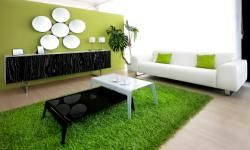As the Earth gets warmer and energy gets more expensive, "high-efficiency," in all its forms, is the grand designation of the 21st century. Cars, appliances and now entire homes have made the jump into the "green" realm, and eco-living doesn't stop with solar panels, tankless water heaters and double-paned glass. Aesthetics are going green, too.
We're not talking about trendy sculptures made of trash. We're talking about counters and furniture made of trash -- or at least what would've been trash. We're talking natural walls, fumeless paints and light bulbs that last practically forever.
Advertisement
Environmental stewardship meets the pursuit of beauty in the newest -- or the newly rediscovered -- green design materials. Here, 10 of the biggest trends in eco-friendly interiors, beginning with a surprisingly renewable stalk you could use in every room of the house.
Good as new
Donate your old furniture to a local furniture recycler. They'll turn your unwanted pieces into something covetable, saving it from the landfill. Get more tips at FutureFriendly.com
